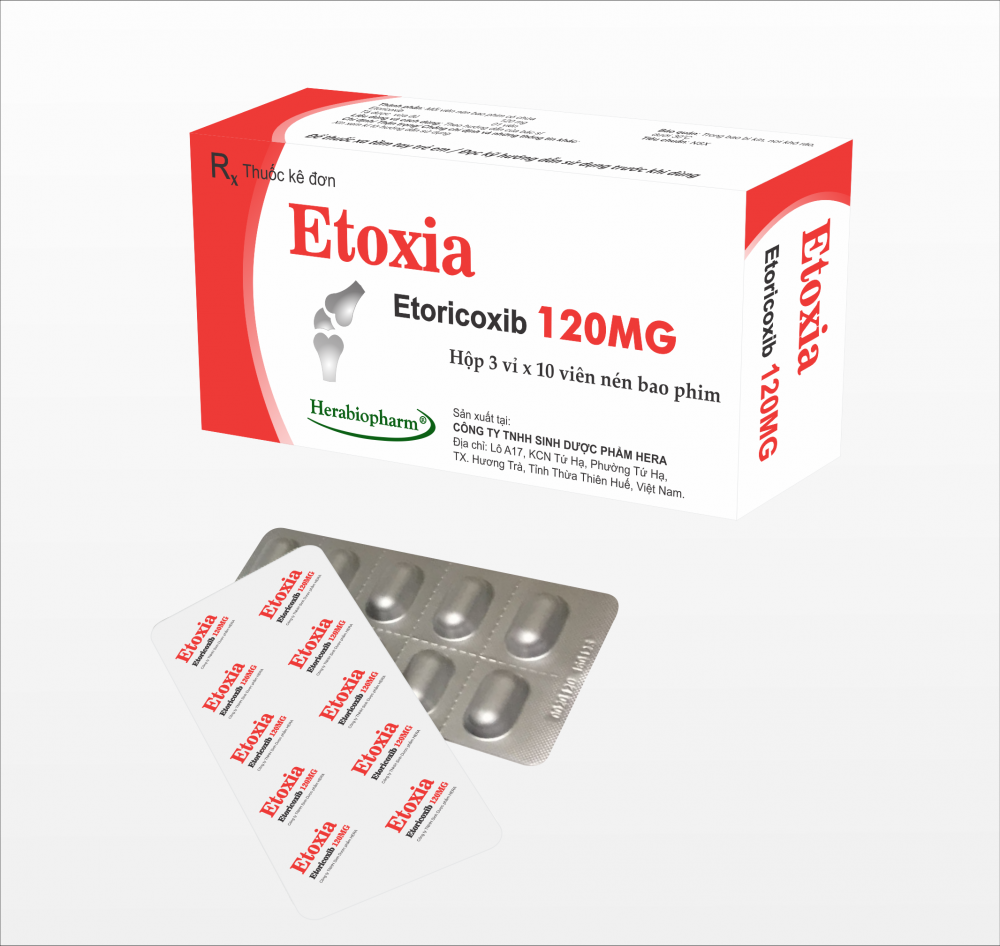ETOXIA
- Packing3 blister packs of 10 tablets
- Shelf life36 months
- CompositionEtoricoxib 120 mg
- Posology and pharmaceutical formFilm-coated tablet
Summary of product characteristic
-
Indications, posology and method of administration
THERAPEUTIC INDICATIONS
Etoricoxib is indicated in adults and adolescents 16 years of age and older for:
- The symptomatic relief of osteoarthritis (OA), rheumatoid arthritis (RA), ankylosing spondylitis, and the pain and signs of inflammation associated with acute gouty arthritis.
- The short-term treatment of moderate pain associated with dental surgery.
The decision to prescribe a selective COX-2 inhibitor should be based on an assessment of the individual patient's overall risks.
POSOLOGY AND METHOD OF ADMINISTRATION
Posology:
As the cardiovascular risks of etoricoxib may increase with dose and duration of exposure, the shortest duration possible and the lowest effective daily dose should be used. The patient's need for symptomatic relief and response to therapy should be re-evaluated periodically, especially in patients with osteoarthritis.
Osteoarthritis
The recommended dose is 30 mg once daily. In some patients with insufficient relief from symptoms, an increased dose of 60 mg once daily may increase efficacy. In the absence of an increase in therapeutic benefit, other therapeutic options should be considered.
Rheumatoid arthritis, ankylosing spondylitis
The recommended dose is 60 mg once daily. In some patients with insufficient relief from symptoms, an increased dose of 90 mg once daily may increase efficacy. Once the patient is clinically stabilised, down-titration to a 60 mg once daily dose may be appropriate. In the absence of an increase in therapeutic benefit, other therapeutic options should be considered.
Acute pain conditions
For acute pain conditions, etoricoxib should be used only for the acute symptomatic period.
Acute gouty arthritis
The recommended dose is 120 mg once daily. In clinical trials for acute gouty arthritis, etoricoxib was given for 8 days.
Postoperative dental surgery pain
The recommended dose is 90 mg once daily, limited to a maximum of 3 days. Some patients may require other postoperative analgesia in addition to etoricoxib during the three-day treatment period.
Doses greater than those recommended for each indication have either not demonstrated additional efficacy or have not been studied. Therefore:
The dose for OA should not exceed 60 mg daily.
The dose for RA and ankylosing spondylitis should not exceed 90 mg daily.
The dose for acute gout should not exceed 120 mg daily, limited to a maximum of 8 days treatment.
The dose for postoperative acute dental surgery pain should not exceed 90 mg daily, limited to a maximum of 3 days.
Elderly patients
No dosage adjustment is necessary for elderly patients. As with other drugs, caution should be exercised in elderly.
Patients with hepatic impairment
Regardless of indication, in patients with mild hepatic dysfunction (Child-Pugh score 5-6) a dose of 60 mg once daily should not be exceeded.
In patients with moderate hepatic dysfunction (Child-Pugh score 7-9), regardless of indication, the dose of 30 mg once daily should not be exceeded.
Clinical experience is limited particularly in patients with moderate hepatic dysfunction and caution is advised.
There is no clinical experience in patients with severe hepatic dysfunction (Child-Pugh score ≥ 10); therefore, its use is contra-indicated in these patients.
Patients with renal impairment
No dosage adjustment is necessary for patients with creatinine clearance ≥ 30 mL/min. The use of etoricoxib in patients with creatinine clearance < 30 mL/min is contra-indicated.
Paediatric population
Etoricoxib is contra-indicated in children and adolescents under 16 years of age.
Method of administration:
Etoricoxib is administered orally and may be taken with or without food. The onset of the effect of the medicinal product may be faster when etoricoxib is administered without food. This should be considered when rapid symptomatic relief is needed. CONTRAINDICATIONS
- Hypersensitivity to the active substance or to any of the excipients.
- Active peptic ulceration or active gastro-intestinal (GI) bleeding.
- Patients who, after taking acetylsalicylic acid or NSAIDs including COX-2 (cyclooxygenase-2) inhibitors, experience bronchospasm, acute rhinitis, nasal polyps, angioneurotic oedema, urticaria, or allergic-type reactions.
- Pregnancy and lactation.
- Severe hepatic dysfunction (serum albumin < 25 g/L or Child-Pugh score ≥ 10).
- Estimated renal creatinine clearance < 30 mL/min.
- Children and adolescents under 16 years of age.
- Inflammatory bowel disease.
- Congestive heart failure (NYHA II-IV).
- Patients with hypertension whose blood pressure is persistently elevated above 140/90 mmHg and has not been adequately controlled.
- Established ischaemic heart disease, peripheral arterial disease, and/or cerebrovascular disease.
This information is for reference only. Please read the leaflet inside.
